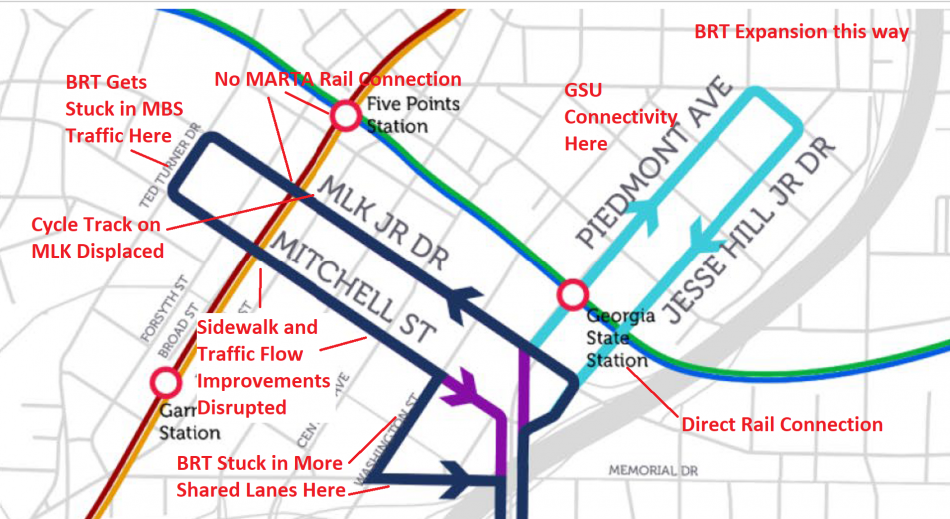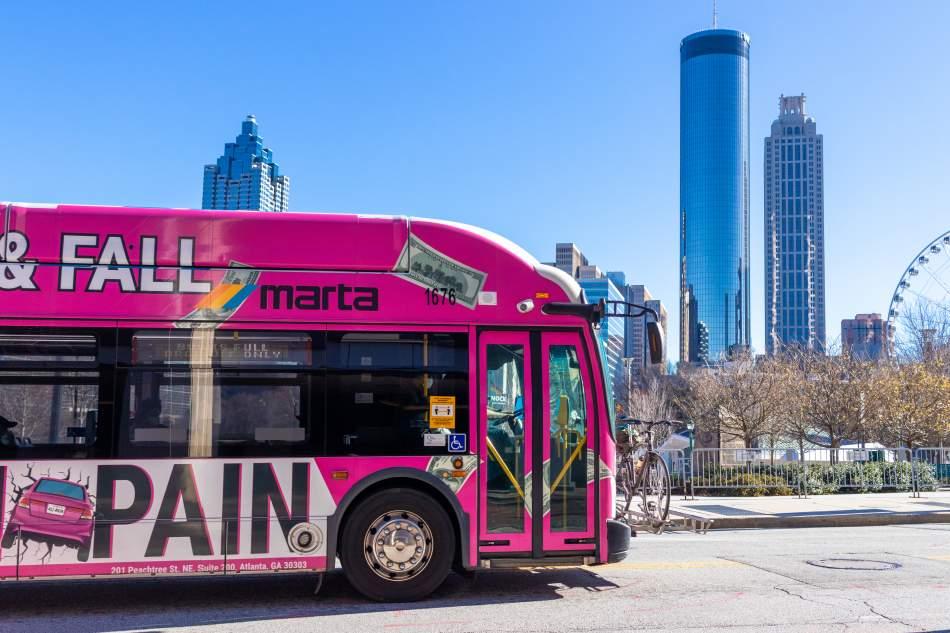Editor’s note: As numerous high-rise residential projects attest, the population of downtown Atlanta is expected to quickly trend upward in coming years. Like residents of any urban center, those downtown dwellers are going to expect convenient public transportation throughout the district. MARTA buses mired in the same traffic as Regular Joe’s Honda won’t cut it, in the eyes of the Atlanta Downtown Neighborhood Association.
John Von Hollen, an ADNA transportation committee and board member, recently reached out to Urbanize Atlanta about an effort the group feels will “get Atlanta’s first Bus Rapid Transit line back in its dedicated lanes downtown” and effectively “save MARTA BRT.”
The neighborhood group has compiled an open letter, as published below, calling for a change in approach to where the BRT route is implemented. The ADNA’s preferred route would more swiftly move passengers around the city, connect to existing MARTA rail, and position the BRT system for future growth, they feel.
“Some individuals have been trying to get these addressed for years, and we’re now seeking broader support and awareness in order to correct the design, before millions of dollars are spent going the wrong direction,” Von Hollen wrote in an email. “We’re having positive initial discussions with key stakeholders, including other neighborhoods, residents, property owners, businesses, and elected officials as well.”
ADNA’s thoughts are outlined in the below letter, which has been edited for clarity and length:
...
Dear Atlanta,
We ask you to amplify our voices and add your name to this open letter to support our efforts to save MARTA’s Summerhill Bus Rapid Transit (BRT) line.
The original route that was approved by Atlanta City Council and the Federal Transit Authority (FTA)—the one that received a TIGER grant—has been changed. A key section in downtown Atlanta has been replaced with a “Locally Preferred Alternative” that the locals do not prefer!
Crucially, this new route has three large sections in downtown where it will have to operate in "shared" traffic lanes in contradiction of BRT standards, slowing service and reducing ridership during peak times. In addition, this new route is in conflict with previously adopted plans, including the Downtown Master Plan, and it would not support any known plans for expanding the BRT system through the region, such as the "Hashtag BRT" system plan adopted in the Atlanta City Design.
When this change to the route’s downtown section was made in 2019, little outreach was done to key stakeholders, such as the Atlanta Downtown Neighborhood Association (ADNA) and the approximately14,500 (and rapidly growing) downtown residents most directly impacted. Those who did manage to hear about and attend the meetings—all of which were held outside our downtown neighborhood—did not get the complete story.
Presenters portrayed a choice between the original “northern” BRT route, connecting with just the east-west heavy rail transit (HRT) line, or changing to this current “western” BRT route, which would offer connections to both east-west and north-south HRT lines, including a connection to the central “Five Points” transit station. Most respondents understandably voted to change to the current “western” BRT route given that incomplete information.
In actuality, the “western” BRT route dumps riders in the middle of South Downtown without direct connection to any current or planned rail!
 The ADNA's preferred route is depicted in light blue here. Courtesy of Atlanta Downtown Neighborhood Association
The ADNA's preferred route is depicted in light blue here. Courtesy of Atlanta Downtown Neighborhood Association
The original “northern” BRT route offers a direct connection to MARTA’s east-west HRT line, the new light rail transit (LRT) line, and supports a faster connection to the central Five Points Station via a short walk or taking the rail one stop west.
It also supports future extensions of the BRT line to additional areas of the city, including Lakewood, Midtown, Buckhead, direct connections to the existing north-south HRT line, and connections to several more planned transit routes.
According to the latest round of meetings, we are at "60 percent design," and that design won't be finished for another year. It should not be too late to correct this error in the route, especially since this is simply returning to a previously approved route for this BRT line.
That is the whole point of spending all this time and money in the design phase—to get this done right and avoid wasting money later in the process. We’re aware there is a clock ticking for the $12.6-million federal grant that was awarded, but there should be plenty of time to make these design changes. And if not, the FTA is able to put the funds on hold so we can take the time to get this right.
On top of that, the grant is less than 20 percent of the cost of the project, and we’ll waste more than that grant amount undoing the wrong BRT infrastructure in downtown, if we don't correct this now.
This current “western” BRT route also jeopardizes existing plans to bring cycle tracks, wider sidewalks, and outdoor dining to downtown streets as well as upending partially funded plans to restore two-way traffic flow planned along these corridors. Even if those plans manage to survive, other sacrifices will have to be made and more money spent to rework them.
We’re working to get in contact with as many key stakeholders as we can. In all of the discussions we’ve had, key groups are supportive of these efforts to correct this routing. Please help us to continue engaging other affected individuals and groups, NPUs, neighborhood organizations, city council members, and any other elected officials who want Atlanta to have great transit.
Wishing the best for the future of BRT in the city we love,
Atlanta Downtown Neighborhood Association (ADNA)
• Recent downtown news, discussion (Urbanize Atlanta)







